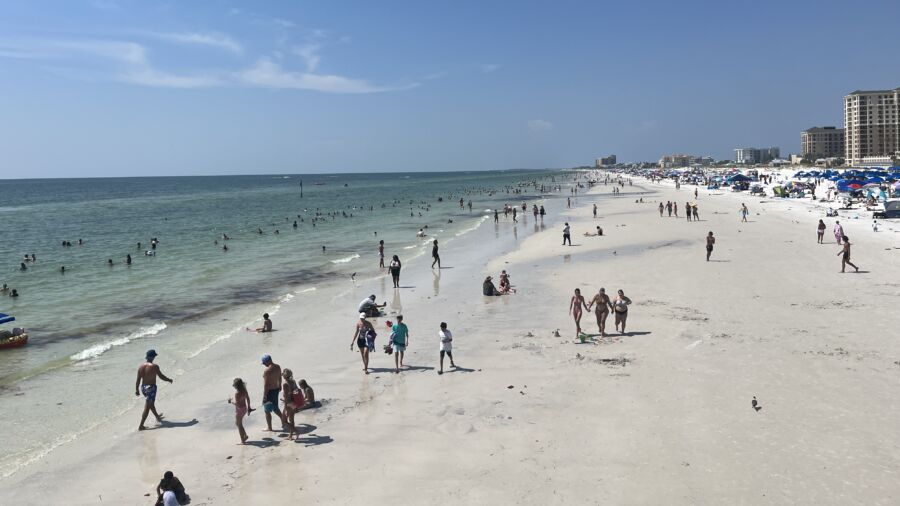Five people are confirmed dead in the Tampa Bay area due to a rare type of flesh-eating bacteria, Vibrio vulnificus, said the Florida Department of Health in a recent update.
Those deaths occurred in Pasco, Polk, Sarasota, and Hillsborough counties since January of this year, the agency said. There have been 26 reported cases across the state so far this year, while in 2022, there were 74 total cases and 17 deaths. That was likely in part due to Hurricane Ian making landfall last year.
The Florida Health website says that a person can become infected with the bacteria after eating raw shellfish, namely oysters, or entering brackish seawater with an open wound. Brackish water occurs when freshwater mixes with ocean water—like when a river meets the sea.
“Individuals who are immunocompromised, e.g chronic liver disease, kidney disease, or weakened immune system, should wear proper foot protection to prevent cuts and injury caused by rocks and shells on the beach,” says Florida’s Health Department website.
Some Health officials called on people not to enter brackish water if they have fresh scrapes, cuts, or other skin abrasions.
“Whenever you have a break in the skin and you’re in a marine environment then theoretically you’re at risk,” Dr. Eric Shamas, an emergency medicine physician at Bayfront Health St. Petersburg, told WFLA-TV. “It’s very important to keep in mind these severe infections are very rare.”
“If you have wounds, maybe stay out of the water,” Dr. Shamas added. “If you suffer a cut while in the water, just wash it out very thoroughly with soap and water. Monitor your symptoms and follow up with your doctor if you have any questions.”
The Centers for Disease Control and Prevention (CDC) says that some Vibrio vulnificus infections can lead to a condition called necrotizing fasciitis, where the flesh near an open wound dies off. The condition can be caused by other forms of bacteria, not just the vibrio genus.
According to the federal health agency, the bacteria can require intensive care or even limb amputations. And about one in five people with the infection die, sometimes within about 24 hours of contracting it.
“Cover your wound with a waterproof bandage if it could come into contact with saltwater, brackish water, or raw or undercooked seafood and its juices. This contact can happen during everyday activities, such as swimming, fishing, or walking on the beach. It could also happen when a hurricane or storm surge causes flooding,” the agency notes.
While anyone can contract the bacteria, the infection can be more severe in people with compromised immune systems. It cannot be transmitted via person to person, but individuals who are experiencing symptoms of the infection should seek medical attention as soon as possible, officials say.
Symptoms include watery diarrhea along with stomach cramping, nausea, vomiting, and fever. For an infection of the bloodstream, symptoms include chills, fever, very low blood pressures, and skin lesions. And for a vibrio wound infection, symptoms include fever, pain, swelling, redness, discoloration, warmth, and discharge, according to the CDC.
The New York State Health Department last week released guidance for residents to identify Vibrio vulnificus infections after the organism was confirmed to have killed two Connecticut residents and one New York resident this summer. New York’s Department of Public Health added that three people were known to have been infected with the bacteria.
“While rare, the vibrio bacterium has unfortunately made it to this region and can be extraordinarily dangerous,” Gov. Kathy Hochul said in a press release. “As we investigate further, it is critical that all New Yorkers stay vigilant and take responsible precautions to keep themselves and their loved ones safe, including protecting open wounds from seawater and for those with compromised immune systems, avoiding raw or undercooked shellfish which may carry the bacteria.”
Three people, between the ages of 60 and 80, were also infected in July in Connecticut, according to the Connecticut Department of Public Health. Two of those three cases died.
“One patient reported consuming raw oysters from an out-of-state establishment. Two patients reported exposure to salt or brackish water in Long Island Sound. Both patients had pre-existing open cuts or wounds or sustained new wounds during these activities which likely led to the infections,” said the agency in a release.
And in July, three North Carolina residents died from the bacteria, officials told The Virginian-Pilot. Two of the three deaths occurred after people with scratches were exposed to brackish water.
A month before that, a 54-year-old Missouri man died after contracting the bacteria after eating raw oysters, NBC News reported.
From The Epoch Times


